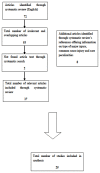Causes, occupational risk and socio-economic determinants of eye injuries: a literature review
- PMID: 34013184
- PMCID: PMC8118212
- DOI: 10.15386/mpr-1761
Causes, occupational risk and socio-economic determinants of eye injuries: a literature review
Abstract
Purpose: This review provides literature views on ocular trauma, with emphasis on common causes of injury, occupational risk, socio-economic factors, management peculiarities and some implications on overall care approach, from prevention to treatment.
Methods: A literature search was performed using key words in PubMed to extract the most relevant articles on ocular injuries, from an occupational point of view. Seventeen relevant articles were included out of seventy-two. Eight relevant articles were found from the references of the articles included and were also added. The total number of articles for this systematic search analysis was twenty-five. Collected information was tabulated in the Appendix.
Results: Most of the included publications were original articles. Many studies were retrospective and cross-sectional with a satisfactory rate of participant recruitment when reported. Most of eye injuries occurred in the workplace. Common eye injuries were due to foreign bodies and corneal abrasions. High-risk occupations included welders, farmers, metalworkers and grinding, construction and manufacturing workers. Most of the injuries could be preventable by using suitable protective eye devices (PED) but appropriate protection is a more complex process than it appears.
Conclusions: Findings of this review showed that it is compulsory to inform people about the risk and consequences of eye injuries. Eye care services should be designed keeping in mind geo-epidemiologic trauma etiology patterns and local health system capacity. Issues of adherence to prevention measures remain object of knowledge dissemination, educational planning and cultural appraisal. Modernizing equipment and respecting workplace regulations are tasks that deserve continuous attention.
Keywords: occupation; ocular injuries; ocular trauma; protection; systematic review; workers.
Figures
References
-
- Négrel AD, Thylefors B. The global impact of eye injuries. Ophthalmic Epidemiol. 1998;5:143–169. - PubMed
-
- Almoosa A, Asal A, Atif M, Ayachit S. Occupational Eye Injury: The Neglected Role of Eye Protection. Bahrain Med Bull. 2017;39:82–84.
-
- Dannenberg AL, Parver LM, Brechner RJ, Khoo L. Penetrating eye injuries in the workplace The National Eye Trauma System Registry. Arch Ophthalmol. 1992;110:843–848. - PubMed
-
- Mela EK, Dvorak GJ, Mantzouranis GA, Giakoumis AP, Blatsios G, Andrikopoulos GK, et al. Ocular trauma in a Greek population: review of 899 cases resulting in hospitalization. Ophthalmic Epidemiol. 2005;12:185–190. - PubMed
-
- Kuhn F, Morris R, Mester V, Witherspoon CD, Mann L, Maisiak R. Epidemiology and socioeconomics. Ophthalmol Clin North Am. 2002;15:145–151. - PubMed
Publication types
LinkOut - more resources
Full Text Sources
Other Literature Sources

